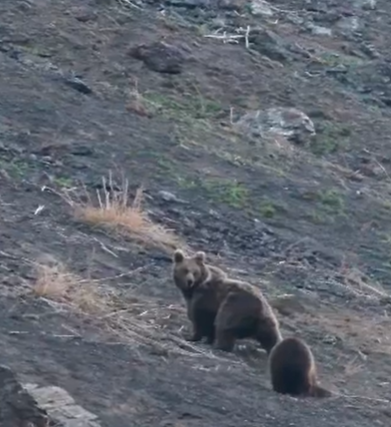Introduction
The Himalayan brown bear (Ursus arctos pruinosus) is a large carnivore found in the high-altitude regions of the Himalayas. This species is considered a subspecies of the brown bear (Ursus arctos) and is found in India, Nepal, Pakistan, Bhutan, and China. It is the largest mammal in the region, males reaching up to 2.2 m (7 ft) long, while females are a little smaller. The bears are omnivorous and hibernate in dens during the winter. It is one of the four species of bear found in India.
The Himalayan brown bear is listed as a vulnerable species by the International Union for Conservation of Nature (IUCN) due to habitat loss and poaching. In this article, we will discuss the threats faced by the Himalayan brown bear and the conservation measures that are and can be taken to protect this species.
Threats to the Himalayan Brown Bear
The numbers of this subspecies used to be far higher as these giants used to roam around the range of Himalayas but due to certain factors The approximate number of Himalayan Brown Bears now in India has dropped to 500-750. The threats are as follows:
Habitat loss
The Himalayan brown bear is found in high-altitude regions above 3,000 meters, including alpine meadows, coniferous forests, and rocky slopes. However, these areas are under threat due to various human activities, such as agriculture, logging, mining, and urbanization. As a result, the Himalayan brown bear is losing its habitat, which is crucial for its survival additionally The tree bearing the state flower of Himachal buransh, is the favourite habitat of the bear.
Due to the high value of the buransh tree, it is being commercially cut causing further destruction to the brown bear’s home. Moreover, the fragmentation of habitat due to the construction of roads and other infrastructure has resulted in the isolation of bear populations, leading to a decrease in genetic diversity and an increased risk of inbreeding.
Poaching
Poaching is one of the most significant threats to the Himalayan brown bear. The bear’s gallbladder is believed to be highly valuable in traditional Asian medicine and is believed to have medicinal properties. As a result, there is a high demand for bear gallbladders in the black market, leading to poaching of bears for their gallbladders. Moreover, the bear’s skin, claws, and meat are also in demand for their commercial value, leading to illegal hunting and poaching. The illegal wildlife trade is truly one of the biggest threats faced by conservationists.
Climate change
Climate change is another significant threat to the Himalayan brown bear. The warming of the Himalayan region is affecting the bear’s habitat and food sources. The melting of glaciers and snowfields is reducing the availability of water and vegetation, which is leading to a decline in the bear’s prey species. Moreover, the changing climate is altering the bear’s behavior, such as their hibernation patterns, mating habits, and migration patterns, leading to a decline in their population.

How are Himalayan Brown Bears being conserved?
The Himalayan brown bear is under protection by governments of many countries hence there are many efforts and regulations which are in action that we will take a look at:
The Wildlife Protection Act prohibits trade of any product related to the Himalayan Brown Bear. The sanctuary for Himalayan Brown Bears is in Himachal Pradesh in the tribal Chumba region. Their estimated population is just 20 in Kugti and 15 in Tundah. In India, brown bears are present in 23 protected areas in the Union Territory of Jammu and Kashmir, and the states of Himachal Pradesh, and Uttarakhand, but only in two of these the bears are regarded as fairly common.
The Himalayan brown bear is protected as a ‘Schedule I’ species in the Indian Wildlife (Protection) Act of 1972 additionally TRAFFIC – India monitors the trade of this species and its products. In 1993, a study was conducted in the bear-inhabited Deosai Plateau in Pakistan controlled Kashmir, following which Deosai was designated as a National Park.
To protect the Himalayan brown bear, several conservation measures need to be taken, including habitat conservation, anti-poaching measures, and climate change mitigation. In India, the Forest Departments have started paying compensation for livestock kills, as well as human injury and death by brown bears.
Habitat conservation
Habitat conservation is crucial for the survival of the Himalayan brown bear. Protected areas such as national parks, wildlife sanctuaries, and conservation reserves can be established to protect the bear’s habitat. These areas can be managed to promote the growth of the bear’s food sources, such as grasslands, shrubs, and berries. Moreover, the connectivity between bear populations can be improved by establishing wildlife corridors, which will allow bears to move between different habitats and prevent isolation.
Anti-poaching measures
Anti-poaching measures are essential to prevent the poaching of Himalayan brown bears. Law enforcement agencies can be strengthened to monitor and prevent poaching activities. Moreover, public awareness campaigns can be initiated to educate people about the importance of conserving the Himalayan brown bear and the consequences of poaching.
Climate change mitigation
Climate change mitigation is necessary to protect the Himalayan brown bear from the impacts of climate change. Measures such as reducing greenhouse gas emissions, promoting renewable energy, and reforestation can be taken to mitigate the impacts of climate change. Moreover, research can be conducted to understand the bear’s adaptation to the changing climate and develop strategies to assist them.
Help us Help Them! Think Wildlife Foundation is a non profit organization with various conservation initiatives. Our most prominent campaign is our Caring for Pari intiative. Pari is a rehabilitated elephant at the Wildlife SoS Hospital. 25% of the profits from our store are donated to the elephant hospital for Pari. Other than buying our wonderful merchandise, you could donate directly to our Caring For Pari fundraiser.
Written by: Aryan Patel
